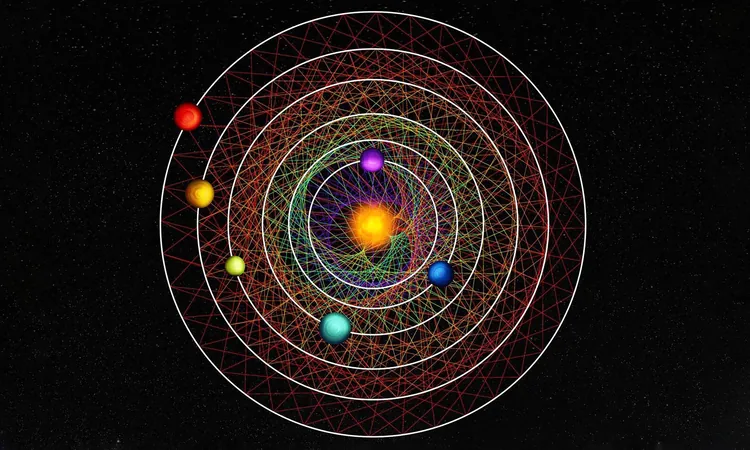
Groundbreaking Discovery: Six-Planet System Unveils Cosmic Harmony
2025-01-13
Author: Ming
Groundbreaking Discovery: Six-Planet System Unveils Cosmic Harmony
In an astonishing breakthrough, researchers have unveiled a striking six-planet system that showcases a unique astronomical configuration. This remarkable discovery, centered around the star HD110067, features six planets whose orbits synchronize in a phenomenon known as resonance.
Resonance in planetary systems denotes a situation where the orbital periods of planets maintain a fixed ratio over millennia, creating a rhythm reminiscent of musical tempos. This rhythmic coordination provides critical insights into why certain stars accumulate stable groups of planets that endure through time.
Led by Rafael Luque from the University of Chicago, the study highlights the rarity of such systems, especially one with six sub-Neptune planets nestled within close orbits. Situated approximately 100 light-years away in the northern constellation Coma Berenices, HD110067 became the focus of attention after astronomers detected unusual dips in the star’s brightness using NASA’s Transiting Exoplanet Survey Satellite (TESS).
Each dip indicated a planet passing in front of the star, and further data from the European Space Agency's CHaracterizing ExOPlanet Satellite (Cheops) confirmed the presence of this intricate planetary chain. “This discovery is set to become a benchmark system for studying the formation and evolution of sub-Neptunes—the most common type of exoplanet,” Luque stated, emphasizing its immense potential for further research.
Sub-Neptunes lie between Earth and Neptune in size, and they are believed to be more abundant than gas giants like Jupiter. Their diverse compositions intrigue scientists, as they may possess thick gaseous atmospheres or dense rocky surfaces. Observing them in resonance offers a window into their stability and long-term evolution.
The resonance phenomenon arises from balanced gravitational nudges among the planets, allowing them to maintain their positions without disruption. However, such stability is rare—only about one percent of multi-planet systems exhibit this synchronized dance. Many others lose their harmonious arrangements due to significant planetary interactions or gravitational disturbances.
Fortunately for the HD110067 system, the absence of larger neighboring planets may have helped these six sub-Neptunes preserve their delicate orbital choreography. This enduring cooperation could illuminate the conditions necessary for planetary systems to form and remain stable.
For astronomers investigating planet formation, every newly discovered system that displays a clear resonance pattern contributes to understanding how dust and gas coalesce to form planets. These findings suggest that while planets might initially start in resonance, dynamic processes such as migration and collisions often lead to their drift.
A pristine system like HD110067 offers a clearer view of the early stages of planet development. Future research will focus on determining the mass and density of each planet, which can reveal their rocky compositions, potential water presence, and atmospheric characteristics.
To delve deeper, astronomers plan to utilize advanced ground-based telescopes and next-generation space observatories to closely monitor the planetary system. By examining the unique resonant dynamics of HD110067, scientists hope to uncover the fundamental reasons for the formation of tightly-knit planetary families while identifying other similar configurations lurking within our galaxy.
This extraordinary six-planet system is not just a mathematical curiosity—it provides a vital puzzle piece in understanding the complex dance of celestial bodies in our universe. The full research paper detailing these findings was published in the journal Nature, and as we continue to explore the cosmos, who knows what other hidden wonders await our discovery?
Stay tuned for more engaging articles and updates on the latest astronomical findings!


 Brasil (PT)
Brasil (PT)
 Canada (EN)
Canada (EN)
 Chile (ES)
Chile (ES)
 Česko (CS)
Česko (CS)
 대한민국 (KO)
대한민국 (KO)
 España (ES)
España (ES)
 France (FR)
France (FR)
 Hong Kong (EN)
Hong Kong (EN)
 Italia (IT)
Italia (IT)
 日本 (JA)
日本 (JA)
 Magyarország (HU)
Magyarország (HU)
 Norge (NO)
Norge (NO)
 Polska (PL)
Polska (PL)
 Schweiz (DE)
Schweiz (DE)
 Singapore (EN)
Singapore (EN)
 Sverige (SV)
Sverige (SV)
 Suomi (FI)
Suomi (FI)
 Türkiye (TR)
Türkiye (TR)
 الإمارات العربية المتحدة (AR)
الإمارات العربية المتحدة (AR)